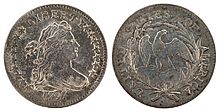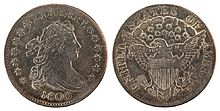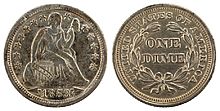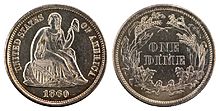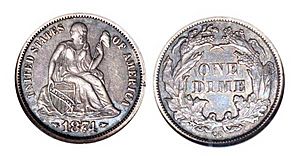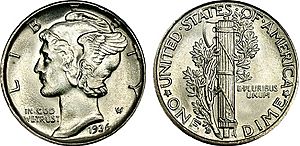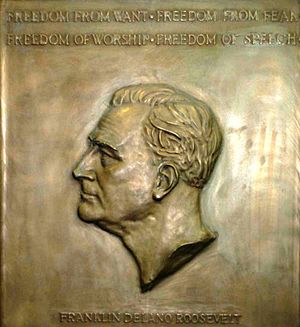Dime (United States coin) facts for kids
The U.S. dime is a small coin from the United States. It is worth ten cents, which is one-tenth of a dollar. The idea for the dime was first approved by a law called the Coinage Act of 1792. Since it was first made, the design of the dime has changed many times.
History of the Dime
The Coinage Act of 1792 was a very important law. It created the dime, along with the cent and the mill. These coins were meant to be parts of a dollar: the dime was 1/10 of a dollar, the cent was 1/100, and the mill was 1/1000.
The idea for a money system based on tens (a decimal system) came from important figures like Thomas Jefferson, Benjamin Franklin, and Alexander Hamilton in 1783. Hamilton, who was the first Secretary of the Treasury, suggested making six types of coins in 1791. One of these was a silver coin that would be worth one-tenth of a dollar.
What Are Dimes Made Of?
From 1796 to 1837, dimes were made mostly of silver (89.24%) and a little copper (10.76%). Because silver was valuable, the coins had to be very small and thin so that the metal itself wasn't worth more than the coin's face value.
Later, with the Seated Liberty dime, the amount of silver was increased to 90%. To keep the value the same, the coin's size was made a bit smaller, from 18.8 millimeters to 17.9 millimeters.
In 1965, a new law called the Coinage Act of 1965 changed dimes completely. They no longer contained any silver. Today's dimes are made of two outer layers of copper (75%) and nickel (25%), wrapped around a core of pure copper.
However, since 1992, the U.S. Mint has made special Silver Proof Sets for collectors. These sets include dimes that are 90% silver and 10% copper, just like the old ones. These special dimes are not meant for everyday use.
Different Dime Designs Over Time
Since the dime was first introduced in 1796, it has had six main designs. The name for each design usually comes from the picture on the front of the coin.
- Draped Bust (1796–1807)
- Capped Bust (1809–1837)
- Seated Liberty (1837–1891)
- Barber (1892–1916)
- Winged Liberty Head (Mercury) (1916–1945)
- Roosevelt (1946–present)
The First "Disme" (1792)
The Coinage Act of 1792 allowed for a coin called a "disme." It was supposed to be one-tenth the weight and value of a silver dollar. In 1792, a small number of dismes were made, but they were never used by the public. Some were even made of copper, which suggests they were test coins. The first dimes made for everyday use didn't appear until 1796. This was because people didn't need them right away, and the United States Mint had some production problems.
Draped Bust Dime (1796–1807)
The Draped Bust dime was the first dime to be used by the public, starting in 1796. It had the same design as other coins at that time. The front showed a picture of Liberty, and the back had a small eagle. This design was created by Robert Scot, the Chief Engraver. The picture of Liberty was based on a drawing of Ann Willing Bingham, a famous woman from Philadelphia. The back showed a small bald eagle on a cloud, surrounded by branches.
Early dimes did not have their value written on them. This was because the law only required cents and half cents to show their value.
All 1796 dimes had 15 stars on the front, representing the 15 states in the country. When Tennessee became the 16th state, some 1797 dimes were made with 16 stars. But then, the Mint Director decided that adding a star for every new state would make the coin too crowded. So, they changed the design to always have 13 stars, representing the original Thirteen Colonies. This means you can find 1797 dimes with either 13 or 16 stars.
In 1798, a new eagle design called the "Heraldic Eagle" appeared on the back. This eagle looked stronger, like the one on the Great Seal of the United States. The Draped Bust design with the Heraldic Eagle continued until 1807. These dimes were made of 89.24% silver and 10.76% copper.
Capped Bust Dime (1809–1837)
The Capped Bust design replaced the Draped Bust. It was created by John Reich, an Assistant Engraver at the Mint. Both the front and back of the coin changed a lot. The new back showed a bald eagle holding arrows (for strength) and an olive branch (for peace). The eagle also had a U.S. shield on its chest.
An important change was that this dime had "10C" written on the back, showing its value in cents. This was the first dime to clearly state its value. Older dimes were recognized by their size. Later dimes would say "ONE DIME" instead of "10C."
Capped Bust dimes made before 1828 are known as the "Large type." They were made without a special collar, which made them look wider. In 1828, a new method was used that made coins thicker and standardized their size. This led to the "Small type" Capped Bust dime, which had a slightly smaller diameter of 18.5 millimeters.
Seated Liberty Dime (1837–1891)
Christian Gobrecht designed the Seated Liberty dime. The front of this coin was used on all silver U.S. coins of that time. The Mint Director wanted a new design that looked like the Britannia image on coins from the United Kingdom.
The front of the coin shows Liberty sitting on a rock. She is wearing a dress and holding a staff with a liberty cap on top. Her right hand holds a shield with "LIBERTY" written on it. The back of the coin says "ONE DIME" surrounded by a wreath. All Seated Liberty dimes were 90% silver and 10% copper, and they were 17.9 millimeters wide. This size and metal mix continued until 1965, when silver was removed from dimes.
There were a few small changes to the Seated Liberty design over the years. The first design in 1837 had no stars on the front. In 1838, 13 stars were added around Liberty. These stars were later replaced with the words "United States of America" in 1860. At the same time, the wreath on the back was changed to include corn, wheat, maple, and oak leaves.
Sometimes, you might see arrows next to the date on these dimes, like in 1853 and 1873. These arrows meant that the coin's mass (weight) had changed. The first change in 1853 was because silver prices were going up. The second change in 1873 was part of a plan to make U.S. coins more accepted around the world. The weight of the dime, quarter, and half-dollar was adjusted to match parts of the French 5-franc coin. This also made sure that the quarter weighed 2.5 times the dime, and the half-dollar weighed twice the quarter. This way, any mix of these coins would always be worth the same amount for a specific weight.
Barber Dime (1892–1916)
The Barber dime is named after its designer, Charles E. Barber. He was the Chief Engraver of the U.S. Mint for many years. This design was also used for the quarter and half-dollar during the same time.
The front of the Barber dime shows Liberty wearing a Phrygian cap (a symbol of freedom), a laurel wreath, and a headband with "LIBERTY" on it. The picture of Liberty was inspired by French coins and ancient Greek and Roman sculptures. The front also has the 13 stars, representing the original colonies. The back of the coin had a wreath and words very similar to the last Seated Liberty dime design.
Barber dimes were made at all four Mints operating at that time. While most Barber dimes are easy for collectors to find, one rare coin is the 1894-S Barber Dime. Only 24 of these were made, and only 9 are known to exist today.
Winged Liberty Head ("Mercury") Dime (1916–1945)
This dime is often called the "Mercury" dime, but it doesn't actually show the Roman god Mercury. Instead, the front shows the mythological goddess Liberty wearing a Phrygian cap with wings. The wings are meant to symbolize freedom of thought. Many people think this dime, designed by Adolph Alexander Weinman, is one of the most beautiful U.S. coin designs ever. The coin's makeup (90% silver, 10% copper) and size (17.9 millimeters) were the same as the Barber dime.
Weinman won a competition in 1915 to design the coin. He is thought to have based his Liberty design on Elsie Kachel Stevens, the wife of a famous poet. The back of the coin shows a fasces (a bundle of rods with an axe) next to an olive branch. This design was meant to show America's readiness for war combined with its desire for peace.
The 1916-D dime is very rare and valuable. Only 264,000 of these were made at the Denver Mint in 1916. Most dimes made at Denver that year were still the older Barber design. Because of this, a 1916-D dime in good condition can be worth thousands of dollars. Be careful when buying, as some common 1916 dimes from Philadelphia have had a "D" added to them to look like the rare ones.
Many "Mercury" dimes have small errors, like a missing line in the middle of the fasces on the back. Coins from 1945 made in Philadelphia rarely have this line complete. Because of this, coins with a full, clear line are worth more. Another valuable error is a 1942 dime where the "2" was stamped over a "1" at the Philadelphia Mint. A similar, but less obvious, error happened at the Denver Mint in the same year.
Franklin D. Roosevelt Dime (1946–present)
Soon after President Franklin D. Roosevelt passed away in 1945, a law was proposed to put his image on the dime. The dime was chosen to honor Roosevelt partly because of his work in starting the National Foundation for Infantile Paralysis, which later became the March of Dimes. This organization raised money for polio research and helped people affected by the disease.
The Roosevelt dime was the first regular U.S. coin designed by a Mint employee in over 40 years. John R. Sinnock, the Chief Engraver, was chosen because he had already designed a medal with Roosevelt's image. Sinnock's first design was rejected, but a second one was accepted. The dime was released to the public on January 30, 1946, which would have been Roosevelt's 64th birthday. Sinnock put his initials ("JS") at the bottom of Roosevelt's neck on the front of the coin. On the back, his design included a torch (for liberty), an olive branch (for peace), and an oak branch (for strength).
When the coin came out, some people spread rumors that the "JS" initials stood for Joseph Stalin, a leader of the Soviet Union. They thought a Soviet agent had put them there! The Mint quickly said this was not true and confirmed the initials were Sinnock's. The same rumor came up again when Sinnock's Franklin half dollar was released in 1948.
Another discussion about Sinnock's design was whether he copied Roosevelt's image from a bas relief (a type of sculpture) made by Selma Burke. This sculpture was shown in Washington, D.C., in September 1945. Sinnock said he did not copy it and that he used his earlier design from the Roosevelt medal.
In 1965, the Coinage Act of 1965 changed the dime's metal again. It went from 90% silver to a "sandwich" of pure copper in the middle, with outer layers of cupronickel (75% copper, 25% nickel). This new mix made the coin weigh about the same (2.268 grams instead of 2.5 grams) and work well in vending machines. Most importantly, it no longer contained valuable silver.
Since 1946, the Roosevelt dime has been made every year. Until 1955, all three Mints (Philadelphia, Denver, and San Francisco) made dimes for everyday use. San Francisco stopped making circulating dimes in 1955 but started again in 1968 for special proof coins only.
You can find "D" and "S" mintmarks (showing where the coin was made) to the left of the torch on dimes made until 1964. From 1968, the mintmarks appear above the date. No mintmarks were used from 1965–67. Philadelphia didn't show a mintmark until 1980. In 1982, a small number of dimes were made without the "P" mintmark by mistake, and these are now valuable.
To celebrate the 50th anniversary of the design, the 1996 mint sets included a "W" mintmarked dime made at the West Point Mint. Only 1,457,000 of these were made, making it the rarest Roosevelt dime at that time. However, even rarer dimes were made in 2015 for a March of Dimes collector set. These included a "P" mint mark reverse proof dime and a "W" mint mark proof dime, with only 75,000 of each made.
Images for kids
See also
 In Spanish: Moneda de 10 centavos de Estados Unidos para niños
In Spanish: Moneda de 10 centavos de Estados Unidos para niños



